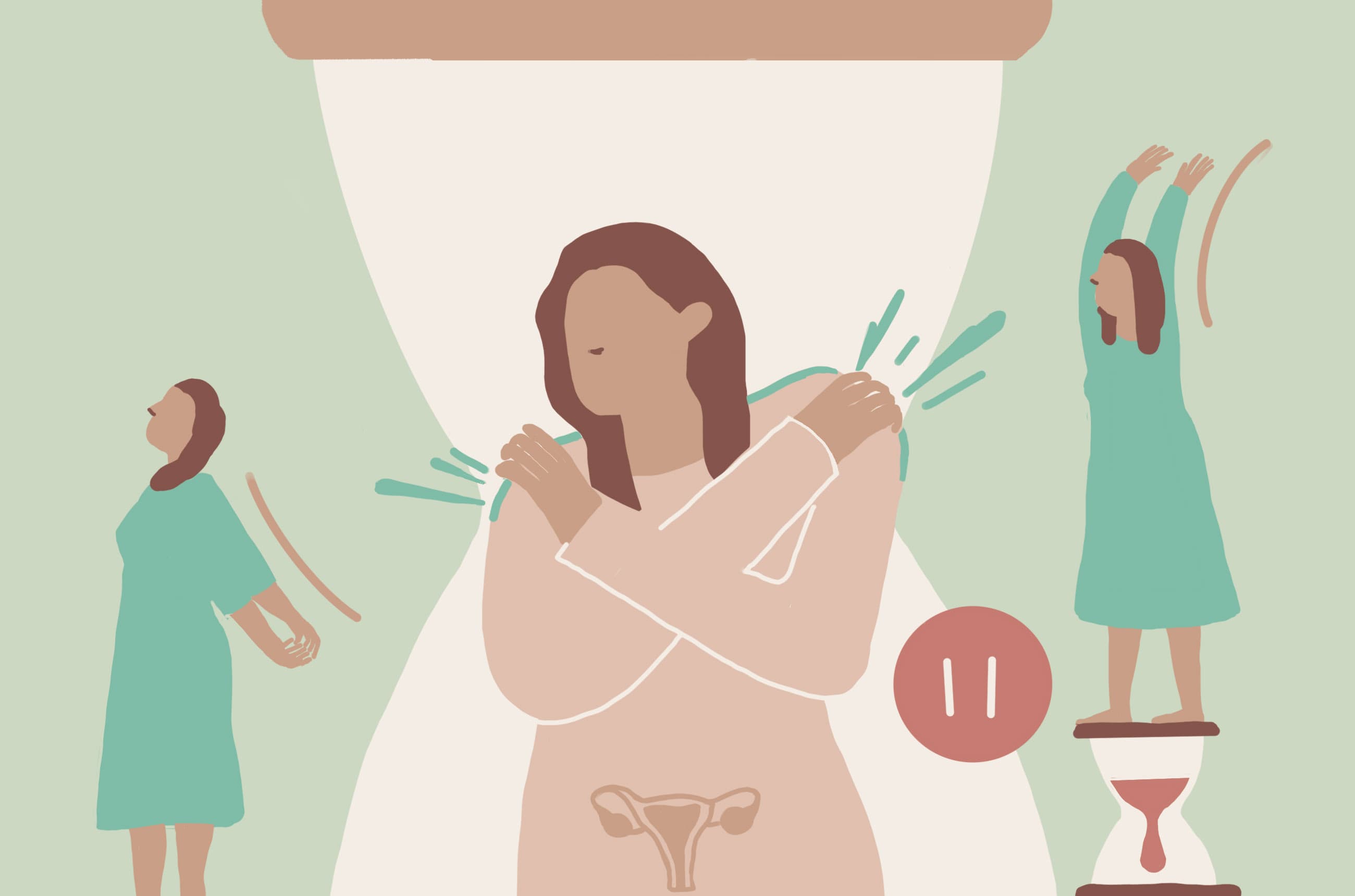This article has been compiled by Vaibhavi Kodnani, a content writer at Proactive For Her.
Frozen shoulder is a severe condition in which there is stiffness, swelling and pain in the shoulder joint. It can occur in one or both shoulder joints. In this state, even the easiest of daily activities become difficult to perform.
Why are women at a higher risk?
A frozen shoulder more commonly happens in people between the ages of 40-60 years. However, women are more likely to develop a frozen shoulder than men - 70% of the people affected with frozen shoulders are women. A sedentary lifestyle, poor posture, hunched or rounded shoulders and hormonal imbalances put women at a higher risk. Experts have also noted a connection between menopause and frozen shoulder as many women who got a frozen shoulder were also going through menopause at the same time. Thus, the fluctuating hormone levels during menopause may be responsible for a frozen shoulder in menopausal women.
Having diabetes also increases the chances of developing a frozen shoulder. Sometimes, the recovery period after a stroke, fracture or mastectomy surgery restricts your arm movements, eventually leading to a frozen shoulder.
How does a frozen shoulder develop?
The shoulder capsule is the tissue that surrounds the shoulder joint. With the development of a frozen shoulder, this capsule hardens and thickens, making the movements difficult. Even the synovial fluid that keeps the joint lubricated reduces, further limiting the movement.
What are the signs and symptoms of a frozen shoulder?
The most common symptoms of a frozen shoulder are:
- Pain and stiffness in the shoulder joints
- Heaviness in the arm
- Difficulty in various movements
- Difficulty in sleeping at night
To elaborate further, there are 3 stages of a frozen shoulder. Each stage has a different timeline and symptoms.

Which activities become difficult to perform with a frozen shoulder?
Frozen shoulder limits both the active and passive range of motion. People with a frozen shoulder have trouble rotating their arm or shoulder outward. It is difficult for them to extend the affected arm or put it behind their back. Apart from the pain restricting their arm movements, it also feels as though their arm is stuck.
Simple activities of daily living get affected due to a frozen shoulder. It becomes difficult, stressful and painful to perform usual tasks like:
- Wearing clothes
- Combing hair
- Reaching to the back pocket
- Reaching out for things overhead
- House chores
- Sleeping on the affected side
What are the treatments for a frozen shoulder?
You must visit a doctor if your symptoms are severe and do not improve with time. The doctor will be able to diagnose and suggest a combination of the following treatment options. The aim is to control the shoulder pain and preserve the maximum range of motion in the shoulder.
Physical therapy
Physical therapy is the most crucial treatment for fixing a frozen shoulder. The therapist will teach you a range of motion exercises to help you regain the mobility of the shoulder joint. Various other mobilization techniques help in achieving the shoulder movement as well.
Medication
To reduce the pain and inflammation, the doctor will suggest you take over the counter painkillers.
Therapeutic ultrasound
Your therapist may also consider a therapeutic ultrasound to help reduce the pain and swelling in the shoulder.
Surgery
In most cases, after 12-18 months of treatment, people get enough relief from the frozen shoulder. However, if the symptoms are persistent even after regular exercise and medication, your doctor may suggest steroid injections or surgery. The surgical procedure removes the scar tissue and adhesions in the joint.
What are the exercises to manage a frozen shoulder?
Various simple exercises can help you recover from a frozen shoulder. These are simple exercises that improve the range of motion, strength and mobility of the affected shoulder. The stretches reduce the stiffness and tightness around the joint and better flexibility. If done regularly, as recommended by the therapist, you can slowly return to a normal state and do all your activities comfortably.
Pendulum stretch
This exercise imitates the motion of a pendulum. Perform this exercise first.
Steps to do it:
- First, relax your shoulders.
- Stand beside a table and place your unaffected arm on the edge of the table for support.
- Then, lean over a bit and let your affected arm hang down.
- Swing that arm in small circles in the clockwise direction.
- Do the same motion in the anti-clockwise direction.
Reps:
10 rotations in each direction, once a day.
Finger walk
Another simple exercise wherein you need to walk, but with your fingers!
Steps to do it:
- Face a wall and stand around three-quarters arm length away from it.
- Using the fingertips of the affected arm, touch the wall at your waist level.
- Gradually start walking your fingers upwards until you reach a comfortable level.
- Then, slowly bring your arm down and repeat the exercise.
- Try to walk further up the wall every time you perform this exercise.
Reps:
10-15 repetitions, twice a day
Assisted shoulder flexion using a stick
For the next two stretching exercises, you need a stick. You can use a lightweight wooden or plastic walking cane or any other small stick that is easy to use. It should not be too heavy or difficult to use.
Steps to do it:
- Lie down on your back with the knees bent.
- Hold the stick firmly in both hands above your waist.
- Slowly bring the stick over the head and go as far as possible.
- Maintain the position and then relax.
Reps:
10 repetitions, 5 hold counts, twice a day
Assisted external rotation using a stick
Use the same stick to do this exercise too.
Steps to do it:
- Lie down on your back with the knees bent.
- Hold the ends of the stick with both your hands.
- Keep the affected arm’s elbow in contact with the body.
- Then, move your affected arm away from the body.
- Maintain this position for some time.
- Return to the initial position and repeat it.
Reps:
10 repetitions, 5 hold counts, twice a day
Towel stretch
Perform this stretch with a regular bathing towel.
Steps to do it:
- Take a towel and hold its ends behind your back with both your hands.
- Hold the towel in a horizontal position.
- Pull the affected arm upwards and stretch it using your good arm.
Reps:
10 repetitions, twice a day
Crossbody reach
Crossbody reach is an easy stretching exercise to help fix the frozen shoulder.
Steps to do it:
- You can either sit or stand to perform this.
- Lift your affected arm across your chest.
- Exert gentle pressure with your unaffected hand at the elbow of the affected one. It will help to stretch the shoulder.
- Hold this stretch for 15-20 seconds.
Reps:
10 repetitions, 15-20 hold counts, once a day
After doing these basic exercises for a few days, the doctor will guide you to perform resisted exercises using weights or therabands. It will help in regaining the strength and control of the shoulders.
How to prevent a frozen shoulder?
You can prevent a frozen shoulder if you take care of yourself by exercising and maintaining a healthy lifestyle.
- Stretch your shoulder and back muscles daily
- Practice good ergonomics while working and using computers/laptops
- Do a range of motion exercises post any injury or surgery
- Exercise regularly
- Keep diabetes in control.
Bottom line
A frozen shoulder takes away your ability to perform basic tasks. Menopausal women, being at a higher risk, should follow preventive measures to avoid getting a frozen shoulder. Regular exercise, frequent breaks in between activities and good lifestyle habits can save you from this condition. Even though it is treatable with exercise and medication, if the symptoms are persistent, visit your doctor without further delay.
Disclaimer: This information is provided for educational purposes and should not be construed as medical advice. Please consult with your healthcare practitioners before undertaking any changes in your diet or adding supplements.
Proactive is a digital clinic for women, offering accessible, personalized, and confidential healthcare solutions. We offer products and services for out-patient health concerns of Indian women, across their lifetime - from puberty to pregnancy to menopause. To know more on the sexual and reproductive health of women, visit https://www.proactiveforher.com/

